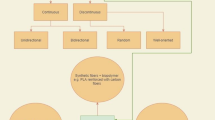Abstract
This paper concentrates on the design of the optimal measurement placement for the parameter identification of two-dimensional orthotropic composites, which is modeled by the boundary element. From the analysis of the well-posedness of the parameter identification processes using the Levenberg–Marquardt method, a performance indicator and an estimation of the maximum bias of identified parameters are deduced. Based on these results, a method for selecting the optimal measurement placement is proposed. The validity of this method is illustrated by some numerical examples. These examples reveal that the measurement placement has significant influence on identification results. Furthermore, an iterative process of selecting measurement placement is suggested for practical implementation.
Similar content being viewed by others
References
Avril S, Grédiac M, Pierron F (2004) Sensitivity of the virtual fields method to noisy data. Comput Mech 34:439–452
Ayorinde EO (1995) Elastic constants of thick orthotropic composite plates. J Compos Mater 29:1025–1039
Brebbia CA, Telles JCF, Wrobel LC (1984) Boundary element techniques–-theory and applications in engi. Springer Verlag, Berlin
Cunha J, Piranda J (1999) Application of model updating techniques in dynamics for the identification of elastic constants of composite materials. Composites: Part B 30:79–85
Cunha J, Piranda J (2000) Identification of stiffness properties of composite tubes from dymanic tests. Exp Mech 40:211–218
Deobald LR, Gibson RF (1988) Determination of elastic constants of orthotropic plates by a modal analysis/Rayleigh-Ritz technique. J Sound Vibration 124:269–283
Fadale TD, Nenarokomov AV, Emery AF (1995) Two approaches to optimal sensor locations. J Heat Trans 117:373–379
Frederiksen PS (1997) Experimental procedure and results for the identification of elastic constants of thick orthotropic plates. J Compos Materials 31:360–382
Frederiksen PS (1998) Parameter uncertainty and design of optimal experiments for the estimation of elastic constants. Int J Solids Struct 35:1241–1260
Fällström K-E (1991) Determing material properties in anisotropic plates using Rayleigh's method. Poly Compos 12:306–314
Fällström K-E, Jonsson M (1991) A nondestructive method to determine material properties in anisotropic plates. Poly Compos 12:293–305
Griffel DH (2002) Applied functional analysis. Dover publications, New York
Haftka RT, Scott EP, Cruz JR (1998) Optimization and experiments: a survey. Appl Mech Rev 51:435–448
Huang LX, Sun XS, Liu YH, Cen ZZ (2004) Parameter identification for two-dimensional orthotropic material bodies by the boundary element method. Eng Anal Bound Elem 28:109–121
Kavanagh KT (1972) Extension of classical experimental techniques for characterizing composite-material behavior. Exp Mech 12:50–56
Kavanagh KT (1973) Experiment versus analysis: computational techniques for the description of static material response. Int J Numer Meth Eng 5:503–515
Kavanagh KT, Clough RW (1971) Finite element applications in the characterization of elastic solids. Int J Solids Struct 7:11–23
Mota Soares CM, Moreira de Freitas M, Araújo AL, Pedersen P (1993) Identification of material properties of composite plate specimens. Compos Struct 25:277–285
Moussu F, Nivoit M (1993) Determination of elastic constants of orthotropic plates by a modal analysis/method of superposition. J Sound Vib 165:149–163
Pedersen P, Frederiksen PS (1992) Identification of orthotropic material moduli by a combined experimental/numerical method. Measurement 10:113–118
Rikards R, Chate A, Gailis G (2001) Identification of elastic properties of laminates based on experiment design. Int J Solids Struct 38:5097–5115
Rus G, Gallego R (2002) Optimization algorithms for identification inverse problems with the boundary element method. Eng Anal Bound Elem 26:315–327
Wang WT, Kam TY (2000) Material characterization of laminated composite plates via static testing. Compos Struct 50:347–352
Xiang ZH, Swoboda G, Cen ZZ (2003) Optimal layout of displacement measurements for parameter identification process in geomechanics. Int J Geomech 3:205–216
Author information
Authors and Affiliations
Corresponding author
Rights and permissions
About this article
Cite this article
Huang, L., Xiang, Z., Sun, X. et al. A study of the optimal measurement placement for parameter identification of orthotropic composites by the boundary element method. Comput Mech 38, 201–209 (2006). https://doi.org/10.1007/s00466-005-0741-y
Received:
Accepted:
Published:
Issue Date:
DOI: https://doi.org/10.1007/s00466-005-0741-y




